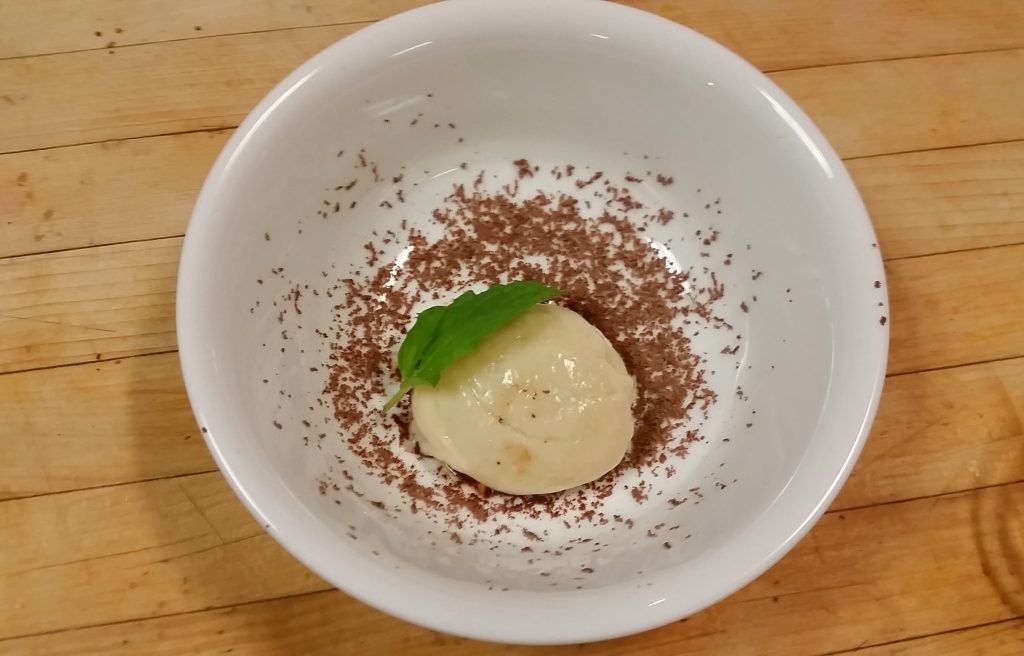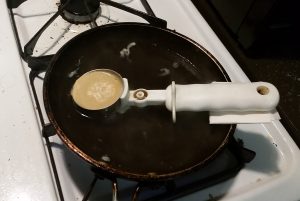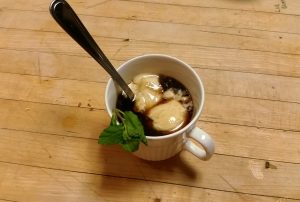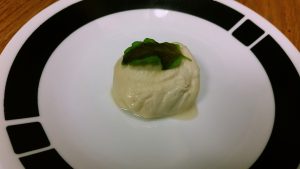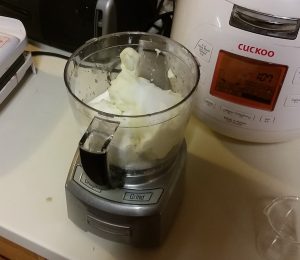This post describes the making of some Hot Ice Cream: scoops of hot (but solid) ice cream that melts as it cools. I made this dish a few years ago and didn’t write it up, but I was talking about it with someone recently, which prompted me to upload a few photos.
I was inspired by this post, this post, this post, and others. All these recipes use methylcellulose (of which I happened to have a lot). Methylcellulose forms a solution in cold water and sets at the water is heated; as the water cools, the gel un-sets, appearing to melt. My understanding is that methylcellulose is popular in cooking for making consomme (clarified broth); previously, this was done with egg whites. ChefSteps has a good description of this:
When you whisk a foam of methylcellulose into the stock and heat it up, it will solidify and rise to the surface, pulling up oils and other small particles with it, and leaving a clear consommé behind. Those tiny droplets of oils and small particles are what make a stock cloudy by scattering light. When you remove them, you have a crystal-clear, golden consommé. The actual advantage of using methylcellulose over egg whites is that egg white proteins carry an electrostatic charge that tends to “gather up” aroma molecules, removing them from the stock and making for a less flavorful consommé. Methylcellulose, then, yields a clarified stock with a deeper and more aromatic flavor profile.
So basically, it’s not actually eaten, it’s just used as a filter and then thrown away. However, as indicated in the above recipes, it is edible (tecnically, more on taste later) and is also used for its unusual temperature-dependent qualities.
One tricky step I encountered is actually mixing the methylcellulose into cold water. The powder clumps, like mixing flour in cold water, but even worse. Wikipedia describes the mechanism at work here as well as the workaround that I used:
As the powder comes into contact with water, a gel layer forms around it, dramatically slowing the diffusion of water into the powder, hence the inside remains dry. A better way is to first mix the powder with hot water, so that the methyl cellulose particles are well dispersed (and so have a much higher effective surface area) in the water, and cool down this dispersion while stirring, leading to the much more rapid dissolution of those particles.
Curiously, this workaround (dispersing the powder in hot water first) leads to an interesting sequence of states of the mixture. First, the mixture is hot but runny because the powder is dispersed throughout but not set. Then, the mixture cools and solvates the methylcellulose, so it is cold and runny. Finally, only when the mixture is heated the second time does it becomes thick.
Anyway, I roughly followed the above recipes to make two batches. In my first batch, I used no mascarpone and upped the amount of methylcellulose (like in the third link) whereas, in my second batch, I used mascarpone as well as earl grey tea to make a tea-flavored hot ice cream. Here are some pictures of the results!
I used some of the first batch to make a Reverse Affogato: scoops of hot, vanilla ice cream with iced coffee poured over. As the coffee cools the hot ice cream, it melts.
This hot ice cream was pretty fun to play around with. Even though the temperature was different, it really looked just like the real thing! Here, I plated a scoop and topped it with a mint leaf. Without thinking, I popped back to my room to grab a camera, but, by the time I had returned, the leaf had become wilted and brown!
The second batch, which I flavored with earl grey tea, tasted better but didn’t solidify so well. It seems like it takes a lot of methylcellulose to get that to happen, and the mascarpone wasn’t helping much.
Ultimately it looked cool, but the texture and taste were really weird. It moved like stiff pudding. Eating it was was like eating sweetened plastic. The methylcellulose coated your tongue and didn’t wash off. The mascarpone version didn’t really taste like ice cream; it tasted like mascarpone. Maybe I’ll try this again with a different type of methylcellulose or less of it. Also, the texture of ice cream arrises from its tiny, crunchy water crystals. Maybe mixing in some salt crystals or course sugar crystals would mimic this.
